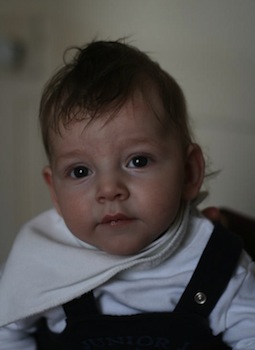Cerebral Palsy and AT: baby Sasha

when Sasha was having no other treatments. There were improvements in his muscular tension, sleep patterns, motor responses and mobility. His overall level of contentment improved and he became more tolerant of background noise and change.
This had a beneficial effect on the whole family and was sustained over a stressful house move, a long car journey and a stay in unfamiliar surroundings, all of which previously would have been distressing for everyone involved.
Background
Prior to the lessons, medical assessment showed that Sasha's mental development was good but his physical development was poor. He became very distressed whenever he was put down or travelling. His sleep was disturbed by twitching; it started when he fell asleep and woke him up, and this was getting worse. He could not bend his arms and was unable to sit up or roll.
Lesson 1. In his first lesson Sasha was alert and looking round the room, sometimes strongly pulling his head back. He was rigid in both arms while his back and legs were floppy. He sat on Kate's lap while I put hands on his arms, shoulders and hands. His arms gradually relaxed and were able to bend.
I gently cradled the back of Sasha's head, supporting it to deter his tendency to brace it back. We worked for 15 minutes before he became restless.
Kate's feedback: "Tonight Martin and I witnessed something incredible. Sasha's sleep twitches affect him every time he falls asleep, unless he is feeding. Tonight he fell asleep in Martin's arms without one twitch! It certainly seems you had a positive effect on him."
The twitching did not resume for several days and Sasha began sleeping for 3 or 4 hours at a time, the longest he had slept to date.
Lesson 2. With Sasha on Kate's lap I worked on his arms which soon relaxed. He was happily looking around and at me, pulling his head back less than before. The work involved gentle hands-on contact to his head, arms and torso to effect muscular release, with Kate frequently moving him around to pacify him. We worked for 20 minutes.
Kate's feedback: "When we got home, Sasha was kicking and reaching out for things so fluidly that I rang my mum to tell her! He had his knees up to his belly which I have never seen him do before. That night Sasha fell asleep while feeding and then woke up after two hours as he has a blocked- up nose. However, although he was clearly irritable and uncomfortable, he did not twitch at all! Progress indeed."
Once again the twitching did not resume until several days after the lesson.
Lesson 3. Sasha had a good sleep the previous night and these are more frequent since we began his lessons. Today I worked on his arms and hands, cradling the back of his head in one hand as before. After 15 minutes Sasha was looser in his neck and limbs and his movements were easier and better coordinated.
I worked with Sasha for 25 minutes with his arms, hands, head and neck before he became restless. Kate said this is the limit of his attention for anything. It was a good lesson and Sasha seemed more contented.
Kate's feedback: "After today's lesson Sasha lifted the fingers of his left hand to his mouth for the first time".
His sleep pattern continued to improve after this lesson.
Lesson 4. Although Sasha was unwell with a blocked-up nose he slept for 7 hours last night - the longest ever. A good night's sleep is common for him now (and his parents too).
Sasha had always needed carrying, rocking and moving about to stop him from crying. This is very tiring and stressful for Kate and before these lessons she had been finding the situation hard to cope with. She describes Sasha now as "a much happier baby" and is sure the lessons have made the difference. We did 15 minutes of AT work today.
Kate's feedback: "When we left you we stopped at Sainsburys. Sasha insisted I carry him in one arm while balancing a basket of shopping with the other. Half way round I felt him start to get twitchy. I rushed my shopping and went to the checkout, by which time he was twitching a lot. He stopped twitching and when I looked down, he was asleep! I was amazed that he had fallen asleep with all the noise and light in Sainsburys."
"Another time I went to Bromley with my mum. We took Sasha in the pram (which he hates). My mum said Sasha was really tired and maybe I should feed him so we could put him asleep in the pram (a far more pleasant alternative to putting him in there awake!) My mum was holding him over her shoulder while we talked about it, and when I looked he was peacefully asleep. He slept in the pram all the way home."
This shows that the change in Sasha's sleep pattern had continued to improve since his first lesson.
April 2010 The family were moving house and it was unsettling Sasha. After the move we couldn't arrange a lesson for a few weeks so Kate kept me informed of any changes.